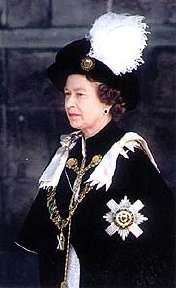 The
Following text and Photos are Copyright the Royal Collection and are reprinted
here by kind permission for Historical information. For their website go
here! The
Following text and Photos are Copyright the Royal Collection and are reprinted
here by kind permission for Historical information. For their website go
here!The Order of the Thistle represents the highest honour
in Scotland, and it is second only in precedence to the Order of the Garter.
The date of the foundation of the Order is not known, although legend has
it that it was founded in 809 when King Achaius made an alliance with the
Emperor Charlemagne. It is possible that the Order may have been founded
by James III (1488-1513), who was responsible for changes in royal symbolism
in Scotland, including the adoption of the thistle as the royal plant badge.
It is said that James V bestowed the insignia of the 'Order of the Burr
or Thissil' on Francis I of France in 1535. Around the time of the Reformation,
the Order was discontinued.
Although some kind of Scottish Order of chivalry existed in the fifteenth and sixteenth centuries, or even much earlier, it was James II (James VII of Scotland) who established the Order with a statutory foundation under new rules in 1687 - to reward Scottish peers who supported the king's political and religious aims. (One statute required that the robe should be 'powdered over with thistles of gold'; a robe from that period still survives, scattered with more than 250 applied thistle motifs.) The statutes stated that the Order was 'to continue to consist of the Sovereign and twelve Knights-Brethren in allusion to the Blessed Saviour and his Twelve Apostles'. After James II (and VII)'s abdication in 1688, the Order fell into disuse once more until it was revived by Queen Anne in 1703 - the number of knights remained at 12. Despite the rebellions of 1715 and 1745, the Old and Young Pretenders (Prince James and Prince Charles 'Bonnie Prince Charlie') appointed Knights of the Thistle (and Garter) in their exiles. The early Hanoverian kings also made use of the Order to reward Scottish nobles who supported the Hanoverian and Protestant cause. Interest in the Order revived when George IV wore the
Thistle during his visit to Scotland in 1822. A statute of 1827 established
the complement of Knights Brethren at 16, and in 1987 a statute enabled
ladies to join the Order. (Extra knights may be created by special statute.)
In 1962, King Olav V of Norway became the first foreigner to be admitted
to the Order for over 200 years.
 Order
of the Thistle - George V's Sash Badge and Star. The Badge depicts St Andrew
carrying his cross, in diamonds and emeralds with the Saint's face and
hands in enamel; the figure is encircled by the Order's motto 'NEMO ME
IMPUNE LACESSIT' in diamonds. In the centre of the star is a raised emerald
and diamond thistle, set in gold on a diamond ground within a diamond border,
encircled by the motto and a small thistle in diamonds above green enamel.
The centre is set on a cross of St Andrew containing 36 large brilliants
and smaller stones. Engraved on reverse: Presented by / Scotland / to
/ H.R.H. The Duke of York / on his Marriage / July 1893 Order
of the Thistle - George V's Sash Badge and Star. The Badge depicts St Andrew
carrying his cross, in diamonds and emeralds with the Saint's face and
hands in enamel; the figure is encircled by the Order's motto 'NEMO ME
IMPUNE LACESSIT' in diamonds. In the centre of the star is a raised emerald
and diamond thistle, set in gold on a diamond ground within a diamond border,
encircled by the motto and a small thistle in diamonds above green enamel.
The centre is set on a cross of St Andrew containing 36 large brilliants
and smaller stones. Engraved on reverse: Presented by / Scotland / to
/ H.R.H. The Duke of York / on his Marriage / July 1893© Royal Collection |
 The
Queen in her green velvet robes as Sovereign of the Order of the Thistle,
as she enters St Giles's Cathedral, Edinburgh, for an Order of the Thistle
service
The
Queen in her green velvet robes as Sovereign of the Order of the Thistle,
as she enters St Giles's Cathedral, Edinburgh, for an Order of the Thistle
service
